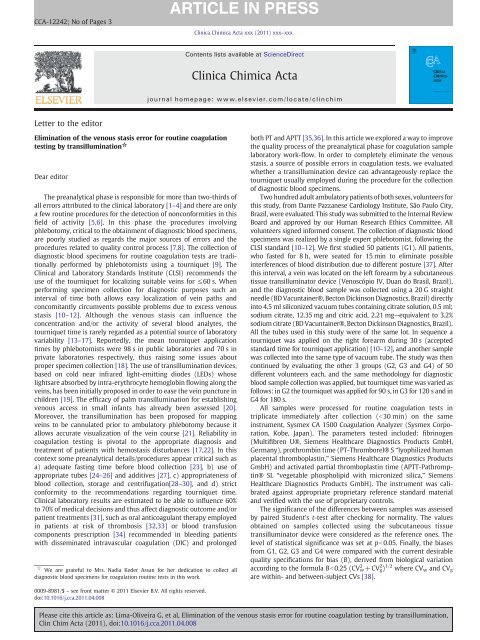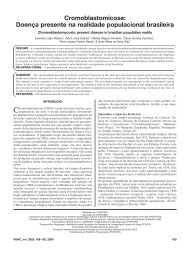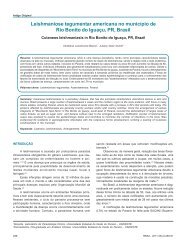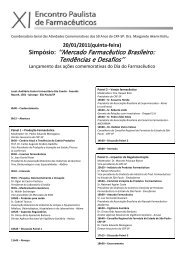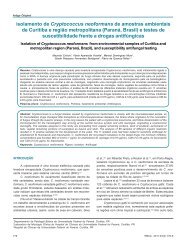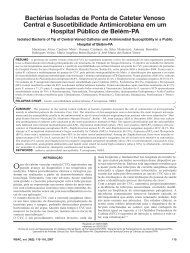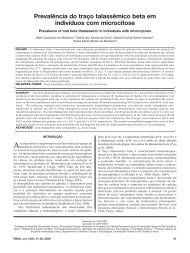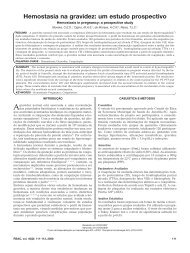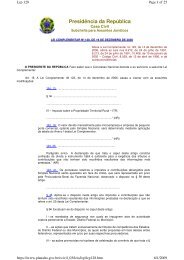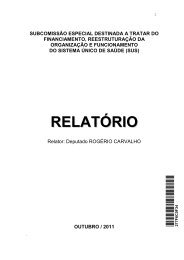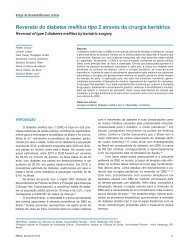Clinica Chimica Acta
Clinica Chimica Acta
Clinica Chimica Acta
You also want an ePaper? Increase the reach of your titles
YUMPU automatically turns print PDFs into web optimized ePapers that Google loves.
CCA-12242; No of Pages 3<br />
<strong>Clinica</strong> <strong>Chimica</strong> <strong>Acta</strong> xxx (2011) xxx–xxx<br />
Contents lists available at ScienceDirect<br />
<strong>Clinica</strong> <strong>Chimica</strong> <strong>Acta</strong><br />
journal homepage: www.elsevier.com/locate/clinchim<br />
Letter to the editor<br />
Elimination of the venous stasis error for routine coagulation<br />
testing by transillumination☆<br />
Dear editor<br />
The preanalytical phase is responsible for more than two-thirds of<br />
all errors attributed to the clinical laboratory [1–4] and there are only<br />
a few routine procedures for the detection of nonconformities in this<br />
field of activity [5,6]. In this phase the procedures involving<br />
phlebotomy, critical to the obtainment of diagnostic blood specimens,<br />
are poorly studied as regards the major sources of errors and the<br />
procedures related to quality control process [7,8]. The collection of<br />
diagnostic blood specimens for routine coagulation tests are traditionally<br />
performed by phlebotomists using a tourniquet [9]. The<br />
<strong>Clinica</strong>l and Laboratory Standards Institute (CLSI) recommends the<br />
use of the tourniquet for localizing suitable veins for ≤60 s. When<br />
performing specimen collection for diagnostic purposes such an<br />
interval of time both allows easy localization of vein paths and<br />
concomitantly circumvents possible problems due to excess venous<br />
stasis [10–12]. Although the venous stasis can influence the<br />
concentration and/or the activity of several blood analytes, the<br />
tourniquet time is rarely regarded as a potential source of laboratory<br />
variability [13–17]. Reportedly, the mean tourniquet application<br />
times by phlebotomists were 98 s in public laboratories and 70 s in<br />
private laboratories respectively, thus raising some issues about<br />
proper specimen collection [18]. The use of transillumination devices,<br />
based on cold near infrared light-emitting diodes (LEDs) whose<br />
lightsare absorbed by intra-erythrocyte hemoglobin flowing along the<br />
veins, has been initially proposed in order to ease the vein puncture in<br />
children [19]. The efficacy of palm transillumination for establishing<br />
venous access in small infants has already been assessed [20].<br />
Moreover, the transillumination has been proposed for mapping<br />
veins to be cannulated prior to ambulatory phlebotomy because it<br />
allows accurate visualization of the vein course [21]. Reliability in<br />
coagulation testing is pivotal to the appropriate diagnosis and<br />
treatment of patients with hemostasis disturbances [17,22]. In this<br />
context some preanalytical details/procedures appear critical such as<br />
a) adequate fasting time before blood collection [23], b) use of<br />
appropriate tubes [24–26] and additives [27], c) appropriateness of<br />
blood collection, storage and centrifugation[28–30], and d) strict<br />
conformity to the recommendations regarding tourniquet time.<br />
<strong>Clinica</strong>l laboratory results are estimated to be able to influence 60%<br />
to 70% of medical decisions and thus affect diagnostic outcome and/or<br />
patient treatments [31], such as oral anticoagulant therapy employed<br />
in patients at risk of thrombosis [32,33] or blood transfusion<br />
components prescription [34] recommended in bleeding patients<br />
with disseminated intravascular coagulation (DIC) and prolonged<br />
☆ We are grateful to Mrs. Nadia Keder Assan for her dedication to collect all<br />
diagnostic blood specimens for coagulation routine tests in this work.<br />
both PT and APTT [35,36]. In this article we explored a way to improve<br />
the quality process of the preanalytical phase for coagulation sample<br />
laboratory work-flow. In order to completely eliminate the venous<br />
stasis, a source of possible errors in coagulation tests, we evaluated<br />
whether a transillumination device can advantageously replace the<br />
tourniquet usually employed during the procedure for the collection<br />
of diagnostic blood specimens.<br />
Two hundred adult ambulatory patients of both sexes, volunteers for<br />
this study, from Dante Pazzanese Cardiology Institute, São Paulo City,<br />
Brazil, were evaluated. This study was submitted to the Internal Review<br />
Board and approved by our Human Research Ethics Committee. All<br />
volunteers signed informed consent. The collection of diagnostic blood<br />
specimens was realized by a single expert phlebotomist, following the<br />
CLSI standard [10–12]. Wefirst studied 50 patients (G1). All patients,<br />
who fasted for 8 h, were seated for 15 min to eliminate possible<br />
interferences of blood distribution due to different posture [37]. After<br />
this interval, a vein was located on the left forearm by a subcutaneous<br />
tissue transilluminator device (Venoscópio IV, Duan do Brasil, Brazil),<br />
and the diagnostic blood sample was collected using a 20 G straight<br />
needle (BD Vacuntainer®, Becton Dickinson Diagnostics, Brazil) directly<br />
into 4.5 ml siliconized vacuum tubes containing citrate solution, 0.5 ml;<br />
sodium citrate, 12.35 mg and citric acid, 2.21 mg—equivalent to 3.2%<br />
sodium citrate (BD Vacuntainer®, Becton Dickinson Diagnostics, Brazil).<br />
All the tubes used in this study were of the same lot. In sequence a<br />
tourniquet was applied on the right forearm during 30 s (accepted<br />
standard time for tourniquet application) [10–12], and another sample<br />
was collected into the same type of vacuum tube. The study was then<br />
continued by evaluating the other 3 groups (G2, G3 and G4) of 50<br />
different volunteers each, and the same methodology for diagnostic<br />
blood sample collection was applied, but tourniquet time was varied as<br />
follows: in G2 the tourniquet was applied for 90 s, in G3 for 120 s and in<br />
G4 for 180 s.<br />
All samples were processed for routine coagulation tests in<br />
triplicate immediately after collection (b30 min) on the same<br />
instrument, Sysmex CA 1500 Coagulation Analyzer (Sysmex Corporation,<br />
Kobe, Japan). The parameters tested included: fibrinogen<br />
(Multifibren U®, Siemens Healthcare Diagnostics Products GmbH,<br />
Germany), prothrombin time (PT-Thromborel® S “lyophilized human<br />
placental thromboplastin,” Siemens Healthcare Diagnostics Products<br />
GmbH) and activated partial thromboplastin time (APTT-Pathromptin®<br />
SL “vegetable phospholipid with micronized silica,” Siemens<br />
Healthcare Diagnostics Products GmbH). The instrument was calibrated<br />
against appropriate proprietary reference standard material<br />
and verified with the use of proprietary controls.<br />
The significance of the differences between samples was assessed<br />
by paired Student's t-test after checking for normality. The values<br />
obtained on samples collected using the subcutaneous tissue<br />
transilluminator device were considered as the reference ones. The<br />
level of statistical significance was set at pb0.05. Finally, the biases<br />
from G1, G2, G3 and G4 were compared with the current desirable<br />
quality specifications for bias (B), derived from biological variation<br />
according to the formula Bb0.25 (CV w 2 +CV g 2 ) 1/2 where CV w and CV g<br />
are within- and between-subject CVs [38].<br />
0009-8981/$ – see front matter © 2011 Elsevier B.V. All rights reserved.<br />
doi:10.1016/j.cca.2011.04.008<br />
Please cite this article as: Lima-Oliveira G, et al, Elimination of the venous stasis error for routine coagulation testing by transillumination,<br />
Clin Chim <strong>Acta</strong> (2011), doi:10.1016/j.cca.2011.04.008
2 Letter to the editor<br />
Table 1<br />
Effects of tourniquet application vs. transilluminator device in blood sample collection on coagulation parameters.<br />
G1 (N=50)<br />
G2 (N=50)<br />
Desirable<br />
bias (%)<br />
Mean value±SD<br />
of transilluminator<br />
Mean value±SD<br />
of 30 s tourniquet<br />
p-Value Mean %<br />
difference<br />
Mean value±SD<br />
of transilluminator<br />
Mean value±SD<br />
of 90 s tourniquet<br />
p-Value Mean %<br />
difference<br />
FIB (mg/dl) 4.8 384.9±94.9<br />
[240.0–604.8]<br />
PT (s) 2.0 12.32±3.20<br />
[10.30–14.21]<br />
APTT (s) 2.3 29.86±4.28<br />
[22.50–33.80]<br />
385.1±94.9<br />
[240.0–605.0]<br />
12.30±3.23<br />
[10.31–14.19]<br />
29.80±4.30<br />
[22.50–33.77]<br />
N0.05 0.05 358±72<br />
[190–512]<br />
N0.05 −0.2 14.47±7.94<br />
[10.9–38.9]<br />
N0.05 −0.2 31.80±7.90<br />
[25.8–36.7]<br />
364±72<br />
[199–525]<br />
14.41 ±8.00<br />
[10.8–37.4]<br />
31.70 ±7.80<br />
[25.3–35.1]<br />
0.002 1.7 ⁎<br />
N0.05 −0.4<br />
N0.05 −0.3<br />
Desirable<br />
bias (%)<br />
G3 (N=50)<br />
Mean value±SD<br />
of transilluminator<br />
FIB (mg/dl) 4.8 288±89<br />
[173–540]<br />
PT (s) 2.0 12.89±1.61<br />
[11.0–18.4]<br />
APTT (s) 2.3 31.70±4.50<br />
[24.1–44.3]<br />
Mean value±SD<br />
of 120 s tourniquet<br />
296±93<br />
[189–545]<br />
12.67±1.57<br />
[10.9–18.0]<br />
31.20±4.40<br />
[20.1–38.7]<br />
p-Value Mean %<br />
difference<br />
G4 (N=50)<br />
Mean value±SD<br />
of transilluminator<br />
0.001 3.0 ⁎⁎ 361±85<br />
[218–495]<br />
0.003 −1.7 ⁎⁎ 12.65±3.29<br />
[11.0–15.1]<br />
0.009 −1.5 ⁎⁎ 30.20±4.40<br />
[22.5–42.3]<br />
Mean value±SD<br />
of 180 s tourniquet<br />
385±95<br />
[240–605]<br />
12.30 ±3.23<br />
[8.7–14.2]<br />
29.80 ±4.30<br />
[22.5–22.8]<br />
p-Value Mean %<br />
difference<br />
0.001 6.7 ⁎⁎<br />
0.001 −2.8 ⁎⁎<br />
0.002 −1.4 ⁎⁎<br />
The values were mean ±SD [range: minimum–maximum]. The bold p-values are statistically significant (pb0.05) and bold mean % differences represent clinically significant<br />
variations, when compared with desirable bias [38].<br />
⁎ pb0.05 vs. G1.<br />
⁎⁎ pb0.05 vs. G1 and G2.<br />
The results of this investigation are shown in Table 1. InG1no<br />
significant increases were observed in coagulation parameters<br />
evaluated after 30 s of the tourniquet application. In G2, after 90 s of<br />
the tourniquet application, a significant increase was observed in<br />
fibrinogen. In G3, significant increases in FIB, PT and APTT were<br />
observed after 120 s of the tourniquet application. In G4 significant<br />
increases were observed in all coagulation tests evaluated after 180 s<br />
of the tourniquet application. However, a clinically significant variation,<br />
as compared with the current desirable quality specifications<br />
[38], was only observed for fibrinogen and PT after 3 min of stasis<br />
(G4).<br />
Our results demonstrate that the prolonged stasis consequent on<br />
tourniquet application for 120 s causes significant reduction of PT and<br />
APTT values in both tests (Table 1), a well known phenomenon of in<br />
vitro activation, thus paving the way for possible errors in critical<br />
patient management and follow-up. As reported, rarely the expert<br />
phlebotomist concludes the collection of diagnostic blood specimens<br />
within 60 s of tourniquet application [18]. Several concurrent causes<br />
might contribute to lengthen the tourniquet time even over 3 min,<br />
such as a difficult location of an appropriate venous access, selection<br />
of the most suited blood collection system, needle insertion into the<br />
vein, collection of many tubes, etc. [3,5,6,9,15–17]. As regards<br />
fibrinogen, the significant increase observed in groups G2, G3, and<br />
G4 appears on overall modest and could be considered not clinically<br />
significant. Nevertheless, even modest increases of fibrinogen, a<br />
marker of inflammation, have been associated with future coronary<br />
heart disease and with unstable and stable coronary artery disease<br />
and coronary complications after interventions [39]. Thus the use of<br />
tourniquet could generate false positives and prospectively induce the<br />
caring physicians to adopt undue treatments. On the contrary,<br />
transillumination devices appear able to eliminate such risk [40]. In<br />
order to deal with some of the above issues, the quality laboratory<br />
manager might devise and adopt improved blood collection procedures<br />
with no or very reduced tourniquet times, e.g., by implementing<br />
transillumination devices after accurate re-evaluation of the<br />
whole blood collection procedures employed by phlebotomist [7].<br />
Obviously such a process of change of blood collection procedures<br />
should be supported by adequate practical instructions provided by<br />
expert professionals. In conclusion, the results we obtained demonstrate<br />
that by employing the recommended procedure of tourniquet<br />
application with gold standard time (30 s) [10–12] in blood collection,<br />
the performance of the coagulation routine testing is identical to that<br />
shown by blood collected with the aid of transillumination. Probably<br />
the errors induced by venous stasis on specialized coagulation tests<br />
like D-dimer, Factors VII, VIII and XII [17] would be eliminated too<br />
using the transillumination. Further insight has to be made in this<br />
respect. Moreover, the whole results demonstrate that transillumination<br />
devices can eliminate the venous stasis and improve the<br />
quality process in preanalytical phase especially in phlebotomy<br />
procedures, mostly when considering that inappropriately prolonged<br />
tourniquet application is rather widespread and no common rules<br />
and/or guidelines appear applied in this respect. These results do<br />
apply to our experimental design, even though they represent a viable<br />
basis for the governance of the preanalytical variability related to<br />
sample stasis.<br />
No potential conflicts of interest relevant to this article were<br />
reported.<br />
References<br />
[1] Wallin O, Soderberg J, Van Guelpen B, Stenlund H, Grankvist K, Brulin C.<br />
Preanalytical venous blood sampling practices demand improvement—a survey of<br />
test-request management, test-tube labelling and information search procedures.<br />
Clin Chim <strong>Acta</strong> 2008;391:91–7.<br />
[2] Lippi G, Bassi A, Brocco G, Montagnana M, Salvagno GL, Guidi GC. Preanalytic error<br />
tracking in a laboratory medicine department: results of a 1-year experience. Clin<br />
Chem 2006;52:1442–3.<br />
[3] Carraro P, Plebani M. Errors in a stat laboratory: types and frequencies 10 years<br />
later. Clin Chem 2007;53:1338–42.<br />
[4] Plebani M, Carraro P. Mistakes in a stat laboratory: types and frequency. Clin Chem<br />
1997;43:1348–51.<br />
[5] Lippi G, Fostini R, Guidi GC. Quality improvement in laboratory medicine: extraanalytical<br />
issues. Clin Lab Med 2008;28:285–294, vii.<br />
[6] Lippi G, Guidi GC. Risk management in the preanalytical phase of laboratory<br />
testing. Clin Chem Lab Med 2007;45:720–7.<br />
[7] Lima-Oliveira G, Picheth G, Sumita NM, Scartezini M. Quality control in the<br />
collection of diagnostic blood specimens: illuminating a dark phase of preanalytical<br />
errors. J Bras Patol Med Lab 2009;45:441–7.<br />
[8] Lippi G, Guidi GC. Preanalytic indicators of laboratory performances and quality<br />
improvement of laboratory testing. Clin Lab 2006;52:457–62.<br />
[9] Lippi G, Salvagno GL, Montagnana M, Franchini M, Guidi GC. Phlebotomy issues<br />
and quality improvement in results of laboratory testing. Clin Lab 2006;52:<br />
217–30.<br />
[10] CLSI, Procedures for the collection of diagnostic blood specimens by venipuncture.<br />
NCCLS H3-A6. 2007.<br />
[11] CLSI, Procedures for the handling and processing of blood specimens for common<br />
laboratory tests. NCCLS H18-A4., 2010.<br />
[12] CLSI, Collection, Transport, and processing of blood specimens for testing plasmabased<br />
coagulation assays and molecular hemostasis assays. NCCLS H21-A5., 2008.<br />
Please cite this article as: Lima-Oliveira G, et al, Elimination of the venous stasis error for routine coagulation testing by transillumination,<br />
Clin Chim <strong>Acta</strong> (2011), doi:10.1016/j.cca.2011.04.008
Letter to the editor<br />
3<br />
[13] Lima-Oliveira G, Picheth G, Assan NK, et al. The effects of tourniquet application vs.<br />
subcutaneous tissue transilluminator device in blood sample collection on<br />
hematological parameters. Award Recipient at the XXth ISLH Symposium. Int<br />
J Lab Hematol 2007;29:37.<br />
[14] Lima-Oliveira G, Picheth G, Assan NK, Ferreira CES, Sumita NM, Scartezini M. The<br />
effects of tourniquet application during 1 minute versus subcutaneous tissue<br />
transilluminator device in blood sample collection on biochemical parameters.<br />
Clin Chem 2007;53(S6):123.<br />
[15] Lippi G, Salvagno GL, Montagnana M, Brocco G, Guidi GC. Influence of short-term<br />
venous stasis on clinical chemistry testing. Clin Chem Lab Med 2005;43:869–75.<br />
[16] Lippi G, Salvagno GL, Montagnana M, Franchini M, Guidi GC. Venous stasis and<br />
routine hematologic testing. Clin Lab Haematol 2006;28:332–7.<br />
[17] Lippi G, Salvagno GL, Montagnana M, Guidi GC. Short-term venous stasis<br />
influences routine coagulation testing. Blood Coagul Fibrinolysis 2005;16:453–8.<br />
[18] Lima-Oliveira G, Picheth G, Sumita NM, Scartezini M. Phlebotomists performance<br />
during blood sample collection in public and private clinical laboratories in São<br />
Paulo City, Brazil. Clin Chem 2007;53(S6):205.<br />
[19] Kuhns LR, Martin AJ, Gildersleeve S, Poznanski AK. Intense transillumination for<br />
infant venipuncture. Radiology 1975;116:734–5.<br />
[20] Goren A, Laufer J, Yativ N, et al. Transillumination of the palm for venipuncture in<br />
infants. Pediatr Emerg Care 2001;17:130–1.<br />
[21] Weiss RA, Goldman MP. Transillumination mapping prior to ambulatory<br />
phlebectomy. Dermatol Surg 1998;24:447–50.<br />
[22] Bonini P, Plebani M, Ceriotti F, Rubboli F. Errors in laboratory medicine. Clin Chem<br />
2002;48:691–8.<br />
[23] Lippi G, Lima-Oliveira G, Salvagno GL, et al. Influence of a light meal on routine<br />
haematological tests. Blood Transfus 2010;8:94–9.<br />
[24] Loh TP, Saw S, Chai V, Sethi SK. Impact of phlebotomy decision support application<br />
on sample collection errors and laboratory efficiency. Clin Chim <strong>Acta</strong> 2011;412<br />
(3–4):393–5.<br />
[25] Gosselin RC, Janatpour K, Larkin EC, Lee YP, Owings JT. Comparison of samples<br />
obtained from 3.2% sodium citrate glass and two 3.2% sodium citrate plastic blood<br />
collection tubes used in coagulation testing. Am J Clin Pathol 2004;122:843–8.<br />
[26] Kratz A, Stanganelli N, Van Cott EM. A comparison of glass and plastic blood<br />
collection tubes for routine and specialized coagulation assays: a comprehensive<br />
study. Arch Pathol Lab Med 2006;130:39–44.<br />
[27] Lippi G, Salvagno GL, Montagnana M, Guidi GC. Influence of two different buffered<br />
sodium citrate concentrations on coagulation testing. Blood Coagul Fibrinolysis<br />
2005;16:381–3.<br />
[28] Salvagno GL, Lippi G, Bassi A, Poli G, Guidi GC. Prevalence and type of preanalytical<br />
problems for inpatients samples in coagulation laboratory. J Eval Clin<br />
Pract 2008;14:351–3.<br />
[29] van Geest-Daalderop JH, Mulder AB, Boonman-de Winter LJ, Hoekstra MM, van<br />
den Besselaar AM. Preanalytical variables and off-site blood collection: influences<br />
on the results of the prothrombin time/international normalized ratio test and<br />
implications for monitoring of oral anticoagulant therapy. Clin Chem 2005;51:<br />
561–8.<br />
[30] Polack B, Schved JF, Boneu B. Preanalytical recommendations of the ‘Groupe<br />
d'Etude sur l'Hemostase et la Thrombose’ (GEHT) for venous blood testing in<br />
hemostasis laboratories. Haemostasis 2001;31:61–8.<br />
[31] Young DS. Effects of preanalytical variables on clinical laboratory tests. 3ed.<br />
Washington: AACC Press; 2007.<br />
[32] Dentali F, Douketis JD, Lim W, Crowther M. Combined aspirin–oral anticoagulant<br />
therapy compared with oral anticoagulant therapy alone among patients at risk<br />
for cardiovascular disease: a meta-analysis of randomized trials. Arch Intern Med<br />
2007;167:117–24.<br />
[33] Anand SS, Yusuf S. Oral anticoagulant therapy in patients with coronary artery<br />
disease: a meta-analysis. JAMA 1999;282:2058–67.<br />
[34] Hallworth M, Hyde K, Cumming A, Peake I. The future for clinical scientists in<br />
laboratory medicine. Clin Lab Haematol 2002;24:197–204.<br />
[35] Levi M, Toh CH, Thachil J, Watson HG. Guidelines for the diagnosis and<br />
management of disseminated intravascular coagulation. British Committee for<br />
Standards in Haematology. Br J Haematol 2009;145:24–33.<br />
[36] Levi M, Meijers JC. DIC: which laboratory tests are most useful. Blood Rev 2011;25<br />
(1):33–7.<br />
[37] Guder WG, Narayanan S, Wisser H, Zawta B. Diagnostic samples: from the patient<br />
to the laboratory: the impact of preanalytical variables on the quality of laboratory<br />
results. 4 ed. Wiley-Blackwell; 2009.<br />
[38] Ricos C, Alvarez V, Cava F, et al. Current databases on biological variation: pros,<br />
cons and progress. Scand J Clin Lab Invest 1999;59:491–500.<br />
[39] Koenig W. Fibrin(ogen) in cardiovascular disease: an update. Thromb Haemost<br />
2003;89:601–9.<br />
[40] Lima-Oliveira G, Lippi G, Salvagno GL, et al. Transillumination: a new tool to<br />
eliminate the impact of venous stasis during the procedure for the collection of<br />
diagnostic blood specimens for routine haematological testing. Int J Lab Hematol.<br />
2011 Mar 17. doi: 10.1111/j.1751-553X.2011.01305.x. [Epub ahead of print].<br />
G. Lima-Oliveira<br />
Laboratory of <strong>Clinica</strong>l Biochemistry,<br />
Department of Life and Reproduction Sciences,<br />
University of Verona, Verona, Italy<br />
Post Graduate Program of Pharmaceutical Sciences,<br />
Department of Medical Pathology Federal University of Parana,<br />
Curitiba, Parana, Brazil<br />
MERCOSUL: Sector Committee of <strong>Clinica</strong>l Analyses and In Vitro<br />
Diagnostics, CSM 20, Rio de Janeiro, Brazil<br />
Brazilian Society of <strong>Clinica</strong>l Analyses on São Paulo State,<br />
São Paulo, Brazil<br />
Corresponding author at: Rua Vicente Licínio, 99 Tijuca,<br />
Rio de Janeiro, RJ 20.270-902, Brazil.<br />
Tel.: +55 11 7800 5868; fax: +55 11 27810712.E-mail address:<br />
dr.g.lima.oliveira@gmail.com.<br />
G.L. Salvagno<br />
Laboratory of <strong>Clinica</strong>l Biochemistry,<br />
Department of Life and Reproduction Sciences,<br />
University of Verona, Verona, Italy<br />
G. Lippi<br />
U.O. Diagnostica Ematochimica,<br />
Azienda Ospedaliero-Universitaria di Parma, Parma, Italy<br />
M. Montagnana<br />
Laboratory of <strong>Clinica</strong>l Biochemistry,<br />
Department of Life and Reproduction Sciences,<br />
University of Verona, Verona, Italy<br />
M. Scartezini<br />
G. Picheth<br />
Post Graduate Program of Pharmaceutical Sciences,<br />
Department of Medical Pathology Federal University of Parana,<br />
Curitiba, Parana, Brazil<br />
G.C. Guidi<br />
Laboratory of <strong>Clinica</strong>l Biochemistry,<br />
Department of Life and Reproduction Sciences,<br />
University of Verona, Verona, Italy<br />
20 December 2010<br />
Available online xxxx<br />
Please cite this article as: Lima-Oliveira G, et al, Elimination of the venous stasis error for routine coagulation testing by transillumination,<br />
Clin Chim <strong>Acta</strong> (2011), doi:10.1016/j.cca.2011.04.008


